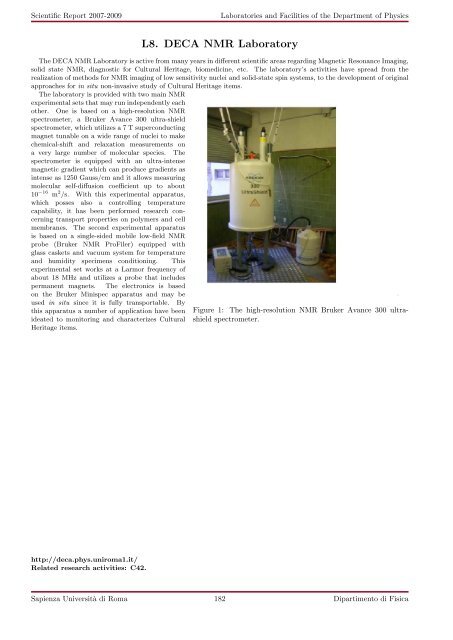download report - Sapienza
download report - Sapienza
download report - Sapienza
Create successful ePaper yourself
Turn your PDF publications into a flip-book with our unique Google optimized e-Paper software.
Scientific Report 2007-2009<br />
Laboratories and Facilities of the Department of Physics<br />
L8. DECA NMR Laboratory<br />
The DECA NMR Laboratory is active from many years in different scientific areas regarding Magnetic Resonance Imaging,<br />
solid state NMR, diagnostic for Cultural Heritage, biomedicine, etc. The laboratory’s activities have spread from the<br />
realization of methods for NMR imaging of low sensitivity nuclei and solid-state spin systems, to the development of original<br />
approaches for in situ non-invasive study of Cultural Heritage items.<br />
The laboratory is provided with two main NMR<br />
experimental sets that may run independently each<br />
other. One is based on a high-resolution NMR<br />
spectrometer, a Bruker Avance 300 ultra-shield<br />
spectrometer, which utilizes a 7 T superconducting<br />
magnet tunable on a wide range of nuclei to make<br />
chemical-shift and relaxation measurements on<br />
a very large number of molecular species. The<br />
spectrometer is equipped with an ultra-intense<br />
magnetic gradient which can produce gradients as<br />
intense as 1250 Gauss/cm and it allows measuring<br />
molecular self-diffusion coefficient up to about<br />
10 −16 m 2 /s. With this experimental apparatus,<br />
which posses also a controlling temperature<br />
capability, it has been performed research concerning<br />
transport properties on polymers and cell<br />
membranes. The second experimental apparatus<br />
is based on a single-sided mobile low-field NMR<br />
probe (Bruker NMR ProFiler) equipped with<br />
glass caskets and vacuum system for temperature<br />
and humidity specimens conditioning. This<br />
experimental set works at a Larmor frequency of<br />
about 18 MHz and utilizes a probe that includes<br />
permanent magnets. The electronics is based<br />
on the Bruker Minispec apparatus and may be<br />
used in situ since it is fully transportable. By<br />
this apparatus a number of application have been<br />
ideated to monitoring and characterizes Cultural<br />
Figure 1: The high-resolution NMR Bruker Avance 300 ultrashield<br />
spectrometer.<br />
Heritage items.<br />
http://deca.phys.uniroma1.it/<br />
Related research activities: C42.<br />
<strong>Sapienza</strong> Università di Roma 182 Dipartimento di Fisica

















